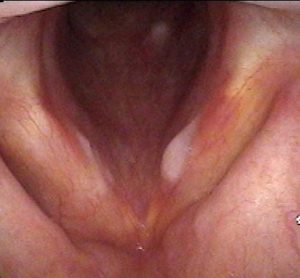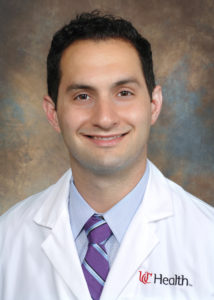In-Office Procedures for Voice Disorders Benefit Patients
John Paul Giliberto, MD, calls his laryngology practice “a unique opportunity to improve the functions that make my patients human – restoring their voice so they can return to conversations with friends, improving their breathing so they play basketball with their children, or helping them swallow so they can enjoy a meal with their family.” Being able to perform evaluation on the throat, vocal cords and esophagus in-office gets the diagnosis quicker and in a more convenient fashion. Dr. Giliberto, assistant professor of otolaryngology‒head and neck surgery, University of Cincinnati Medical Center (UC Medical Center), is helping to expand UC’s laryngology practice. He and his UC Medical Center colleague, John Barrord, MD, offer general ENT services in Middletown, Ohio, where Dr. Giliberto provides the full breadth of laryngological diagnostic services.
Dr. Giliberto’s laryngological training will be helpful in treating voice disorders. These disorders can be the result of both problems with the instrument (the vocal cords) or how the patient is playing their instrument. With videostroboscopy, “we can diagnose vocal cord conditions and abnormalities; our view of the larynx is magnified, and vocal cord vibration is simulated in slow motion. This provides us an outstanding view of the cords and their function that often gives clues to the cause of the voice disorder. That way we can get our patients on the path most likely to get them better,” he says.

This videostroboscopy still shows the vocal cords of a patient with hoarseness. Image courtesy of John Paul Giliberto, MD.
One condition that Dr. Giliberto will be treating in the office is spasmodic dysphonia, a rare but debilitating condition. Laryngeal electromyography is helpful in diagnosing the condition and treating it by directing placement of botulinum toxin injections. For Dr. Giliberto, “medical problems related to the throat are very rewarding to treat.” They require an astute diagnosis, he says, which is aided by listening carefully to the patient’s story – “often, this will point to the diagnosis.” Equally important is having high-quality staff, including a speech pathologist, and state-of-the-art equipment.
Another in-office procedure, which Dr. Giliberto is uniquely trained to perform, is vocal fold augmentation. When a patient develops vocal cord paresis or paralysis, the affected cords lose muscle bulk and tone. During the in-office augmentation, “we provide more bulk, with an injectable filler, to close the gap between the vocal cords and allow the functioning vocal fold to meet the affected cord to make the sounds required for speech,” explained Dr. Giliberto. Often the results are immediate and profound, “it’s a powerful experience for patients to have their voices back,” says Dr. Giliberto.
One of his interests is the treatment of chronic cough, which he characterizes as one of the most commonly reported complaints in ambulatory centers. In 2012, cough was responsible for more than 26 million office visits.1 “While chronic cough is common, the reason for the cough can be difficult to identify – “it’s a vexing and challenging clinical problem – because the diagnoses include sinuses, acid reflux, throat problems, and lung disorders that can result from smoking, such as chronic obstructive pulmonary disease,” says Dr. Giliberto. After a thorough interview and a videostroboscopy, Dr. Giliberto will review the various causes for cough and work with the patient to identify the course of action most likely to result in cough improvement. In particular, he has an interest regarding cough caused by irritated nerves or neuropathy. He was asked to lead the review of a specific class of medications that treat cough related to neuropathy (2016), and he is currently looking at aspects which make response to these drugs more likely (unpublished work).
Prior to his UC Medical Center appointment in 2016, Dr. Giliberto was a laryngology fellow at the University of Washington Medical Center, Seattle, Wash. He received his medical degree from Alpert Medical School, Brown University, Providence, Rhode Island, and completed a residency in otolaryngology at the University of Cincinnati/Cincinnati Children’s Medical Center. He is board certified in otolaryngology and is a member of the American Academy of Otolaryngology – Head and Neck Surgery.
Reference
1. Agency for Healthcare Research and Quality. Assessment and management of chronic cough. Executive Summary, January 7, 2013. Available at http://effectivehealthcare.ahrq.gov/index.cfm/search-for-guides-reviews-and-reports/?pageaction=displayproduct&productid=1370. Accessed January 28, 2017.
Selected Publications
Wiebratcht N, Giliberto JP, Myer C 4th, Casper K, Johnson K. Pilot testing of a novel surgical simulator for endoscopic Zenker’s diverticulotomy. Laryngoscope. 2016. doi: 10.1002/lary.26129.
Giliberto JP, Cohen SM, Misono S. Are neuromodulating medications effective for the treatment of chronic neurogenic cough? Laryngoscope. 2016. doi: 10.1002/lary.26393.
Giliberto JP, Zhu Q, Meyer, TK. Development of a voice disorder work productivity inventory utilizing cognitive interviewing technique. Laryngoscope Investigative Otolaryngology.2016. doi: 10.1002/lio2.40.
John Paul Giliberto, MD
Assistant Professor of Otolaryngology-Head and Neck Surgery
EMAIL: Johnpaul.giliberto@uc.edu
To schedule a consultation please call
(513) 475-8400.


